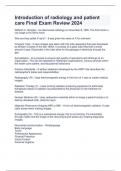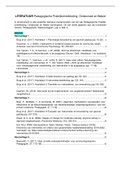Exam (elaborations)
Introduction of radiology and patient care Final Exam Review 2024
Wilhelm C. Rongten - He discovered radiology on November 8, 1895. The first known x-ray image is his wife's hand. Why are they called X-ray's? - It was given the name of X for unknown. Crooke's Tube - X-rays images was taken with this tube apparatus that was developed by William Crookes in the la...
[Show more]




